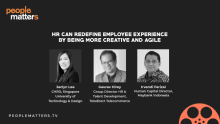Here's how technology is re-shaping HRMS

The aim is to convert useful information into actionable intelligence.
According to an EY Annual Global Security Survey, by 2016 over 70% of organizations will be using some form of cloud system to run its Human Resource Management System (HRMS). Restructuring the HRMS of a company has been one of the main focal points of the shift towards the cloud. Currently, many organizations have a disparate form of HR management systems that collect, store and analyze collected data. There is a lack of cohesive information being provided to HR professionals.
As organizations look to increase the benefits of the HRMS, building a more integrated and cloud-based management service has gained importance. Cloud-based HRMS platforms offer the chance to integrate HR management by automating certain “non- value adding processes” like leave management, reimbursement claims and payroll processes, thus freeing up HR professionals to take care of other “value adding processes” like building leadership abilities and designing learning initiatives within the company.
The use of products that integrate management processes and automate non-value adding steps have increased over time. Though there is an increased awareness about these systems, the urgency with which they need to be implemented is often ignored. Usually, the scepticism arises from a perception that it is difficult to measure the return on investments and a belief that such systems are too costly. But as service providers build on technological disruptions, the case for an effective HRMS is being strengthened.
According to the 2015 KPMG HR Transformation Survey, around 88% of the surveyed respondents said they would be increasing allocated budgets on using new HR technologies. The report indicates that organizations are increasing investments on HRMS, a market which will see exponential growth in the upcoming years. This rise in investments is targeted at exploring newer platforms which provide better results. According to Prasad Rajappan, CEO of ZingHR, “this increase of investments in building integrated HRMS using cloud computing will yield three-pronged results, it will: put employees at the centre, increase efficiency and lower cost structures involved.”
Increased focus on employees
Advances in cloud computing systems are enabling tech startups to create integrated HRMS. These systems are aimed at automating the non- value adding processes to streamline HR. The creation of an integrated HRMS ensures that the HR professional is equipped to manage the entire lifecycle of employees - right from recruiters sourcing candidates on social media to their assessments and onboarding process until their tenure ends in the organisation, can now be managed cohesively. This makes employees central to the process HR management. The aim is not only to run the process efficiently but rather to ensure that the intended change is brought about. An integrated platform serves this purpose by creating a robust system that includes various components like social media and mobile-based management services in order to manage and assess the growth of an employee.
Reduced cost per person
Using cloud-based integrated HRMS has allowed companies to significantly cut down the cost per person per month that companies face while implementing such systems. For example, a medium size company of about 1000 employees will spend less than a dollar per person using cloud-based HRMS. And this figure goes down further for larger organizations. Being a cloud-based system also removes the need for maintaining in-house infrastructure to keep the management systems up and running. With no caveats involved, the organizations also hold the option of switching systems with minimal cost making it a suitable option for companies looking to upgrade their HRMS.
Improved efficiency
Most companies that are currently optimising their work by automating the non-value adding processes stand to benefit from implementing the right HRMS. By utilising the concept of Lean HR, the identification and elimination of non-value-adding steps, an integrated HRMS re-engineers and redesigns the processes; identifies bottlenecks and operations with little value to create a streamlined system of management and help run operations smoothly. Combining Lean HR principles with concepts like geo-tagging and social media are the key to automating HR processes.
The possibility of transferring the entire management system on a cloud-based platform provides a real-time integration of the HRM platforms at one place which is easy to access and cost effective to maintain. Organizations like ZingHR, an end-to-end HR platform that delivers integrated HRMS facilities, built using Microsoft’s Azure cloud platform, enables employees and HR professionals to get a real-time access to advanced solutions on payroll management, performance appraisal and talent management.
With the rapid evolution of HRMS, the answers lie in the automation of specific HR systems that integrates data across various levels of the organisation and generates actionable dashboards for CXOs and other HR professionals to drive business productivity.





